| Weight | 1 lbs |
|---|---|
| Dimensions | 9 × 5 × 2 in |
| host | mouse |
| isotype | IgG |
| clonality | monoclonal |
| concentration | concentrate, predilute |
| applications | IHC |
| reactivity | human |
| available size | 0.1 mL, 0.5 mL, 1 mL concentrated, 7 mL prediluted |
rabbit anti-ATRX monoclonal antibody (ZR244) 6442
Price range: $160.00 through $528.00
Antibody summary
- Rabbit monoclonal to ATRX
- Suitable for: Immunohistochemistry (formalin-fixed, paraffin-embedded tissues)
- Reacts with: Human
- Isotype:IgG
- Control: High-grade glioma
- Visualization: Nuclear
- 0.1, 0.5, 1.0 mL concentrated, 7 mL prediluted
rabbit anti-ATRX monoclonal antibody ZR244 6442
| target relevance |
|---|
| Protein names Transcriptional regulator ATRX (EC 3.6.4.12) (ATP-dependent helicase ATRX) (X-linked helicase II) (X-linked nuclear protein) (XNP) (Znf-HX) |
| Gene names ATRX,ATRX RAD54L XH2 |
| Protein family SNF2/RAD54 helicase family |
| Mass 282587Da |
| Function FUNCTION: Involved in transcriptional regulation and chromatin remodeling. Facilitates DNA replication in multiple cellular environments and is required for efficient replication of a subset of genomic loci. Binds to DNA tandem repeat sequences in both telomeres and euchromatin and in vitro binds DNA quadruplex structures. May help stabilizing G-rich regions into regular chromatin structures by remodeling G4 DNA and incorporating H3.3-containing nucleosomes. Catalytic component of the chromatin remodeling complex ATRX:DAXX which has ATP-dependent DNA translocase activity and catalyzes the replication-independent deposition of histone H3.3 in pericentric DNA repeats outside S-phase and telomeres, and the in vitro remodeling of H3.3-containing nucleosomes. Its heterochromatin targeting is proposed to involve a combinatorial readout of histone H3 modifications (specifically methylation states of H3K9 and H3K4) and association with CBX5. Involved in maintaining telomere structural integrity in embryonic stem cells which probably implies recruitment of CBX5 to telomeres. Reports on the involvement in transcriptional regulation of telomeric repeat-containing RNA (TERRA) are conflicting; according to a report, it is not sufficient to decrease chromatin condensation at telomeres nor to increase expression of telomeric RNA in fibroblasts (PubMed:24500201). May be involved in telomere maintenance via recombination in ALT (alternative lengthening of telomeres) cell lines. Acts as a negative regulator of chromatin incorporation of transcriptionally repressive histone MACROH2A1, particularily at telomeres and the alpha-globin cluster in erythroleukemic cells. Participates in the allele-specific gene expression at the imprinted IGF2/H19 gene locus. On the maternal allele, required for the chromatin occupancy of SMC1 and CTCTF within the H19 imprinting control region (ICR) and involved in esatblishment of histone tails modifications in the ICR. May be involved in brain development and facial morphogenesis. Binds to zinc-finger coding genes with atypical chromatin signatures and regulates its H3K9me3 levels. Forms a complex with ZNF274, TRIM28 and SETDB1 to facilitate the deposition and maintenance of H3K9me3 at the 3' exons of zinc-finger genes (PubMed:27029610). {ECO:0000269|PubMed:12953102, ECO:0000269|PubMed:14990586, ECO:0000269|PubMed:20504901, ECO:0000269|PubMed:20651253, ECO:0000269|PubMed:21029860, ECO:0000269|PubMed:22391447, ECO:0000269|PubMed:22829774, ECO:0000269|PubMed:24500201, ECO:0000269|PubMed:27029610}. |
| Catalytic activity CATALYTIC ACTIVITY: Reaction=ATP + H2O = ADP + phosphate + H(+); Xref=Rhea:RHEA:13065, ChEBI:CHEBI:15377, ChEBI:CHEBI:15378, ChEBI:CHEBI:30616, ChEBI:CHEBI:43474, ChEBI:CHEBI:456216; EC=3.6.4.12; |
| Subellular location SUBCELLULAR LOCATION: Nucleus. Chromosome, telomere. Nucleus, PML body. Note=Associated with pericentromeric heterochromatin during interphase and mitosis, probably by interacting with CBX5/HP1 alpha. Colocalizes with histone H3.3, DAXX, HIRA and ASF1A at PML-nuclear bodies. Colocalizes with cohesin (SMC1 and SMC3) and MECP2 at the maternal H19 ICR (By similarity). {ECO:0000250}. |
| Tissues TISSUE SPECIFICITY: Ubiquitous. |
| Structure SUBUNIT: Interacts with DAXX to form the chromatin remodeling complex ATRX:DAXX. Probably binds EZH2. Binds annexin V in a calcium and phosphatidylcholine/phosphatidylserine-dependent manner. Interacts directly with CBX5 via the PxVxL motif. Interacts with RAD50, MRE11 and NBN; indicative for an association with the MRN complex. Interacts with histone MACROH2A1. Interacts with histone H3 peptides methylated at 'Lys-10' with preferences H3K9me3 > H3K9me2 > H3K9me1. Interacts with histone H3 peptides unmethylated at 'Lys-5' (H3K4me0). Interacts with MECP2, SMC1 and SMC3. Interacts with SETDB1, TRIM28 and ZNF274 (PubMed:27029610). {ECO:0000269|PubMed:10699177, ECO:0000269|PubMed:12953102, ECO:0000269|PubMed:14990586, ECO:0000269|PubMed:15882967, ECO:0000269|PubMed:17296936, ECO:0000269|PubMed:21421568, ECO:0000269|PubMed:21666677, ECO:0000269|PubMed:21666679, ECO:0000269|PubMed:22391447, ECO:0000269|PubMed:24651726, ECO:0000269|PubMed:27029610, ECO:0000269|PubMed:9499421}. |
| Post-translational modification PTM: Phosphorylated at serine residues during mitose. Phosphorylation may promote the release from the nuclear matrix and progression to mitosis. {ECO:0000269|PubMed:10699177}. |
| Domain DOMAIN: The ADD domain predominantly interacts with histone H3 trimethylated at 'Lys-10'(H3K9me3) (and to a lesser extent H3 mono- or dimethylated at 'Lys-10') and simultaneously to histone H3 unmethylated at 'Lys-5' (H3K4me0). The interaction with H3K9me3 is disrupted by the presence of H3K4me3 suggesting a readout of the combined histone H3 methylation state. {ECO:0000269|PubMed:17609377}.; DOMAIN: Contains one Pro-Xaa-Val-Xaa-Leu (PxVxL) motif, which is required for interaction with chromoshadow domains. This motif requires additional residues -7, -6, +4 and +5 of the central Val which contact the chromoshadow domain. {ECO:0000269|PubMed:17609377}. |
| Involvement in disease DISEASE: Alpha-thalassemia/impaired intellectual development syndrome, X-linked (ATRX) [MIM:301040]: A disorder characterized by severe psychomotor retardation, facial dysmorphism, urogenital abnormalities, and alpha-thalassemia. An essential phenotypic trait are hemoglobin H erythrocyte inclusions. {ECO:0000269|PubMed:10204841, ECO:0000269|PubMed:10417298, ECO:0000269|PubMed:10660327, ECO:0000269|PubMed:10995512, ECO:0000269|PubMed:12116232, ECO:0000269|PubMed:14990586, ECO:0000269|PubMed:16955409, ECO:0000269|PubMed:21421568, ECO:0000269|PubMed:7697714, ECO:0000269|PubMed:8968741, ECO:0000269|PubMed:9043863, ECO:0000269|PubMed:9326931}. Note=The disease is caused by variants affecting the gene represented in this entry.; DISEASE: Intellectual disability-hypotonic facies syndrome, X-linked, 1 (MRXHF1) [MIM:309580]: A disorder characterized by significantly below average general intellectual functioning associated with impairments in adaptive behavior and manifested during the developmental period. MRXSHF1 features include severe intellectual disability, dysmorphic facies, and a highly skewed X-inactivation pattern in carrier women. Other more variable features include hypogonadism, deafness, renal anomalies, and mild skeletal defects. {ECO:0000269|PubMed:10398237, ECO:0000269|PubMed:10751095, ECO:0000269|PubMed:11050622, ECO:0000269|PubMed:15565397, ECO:0000269|PubMed:16222662, ECO:0000269|PubMed:8630485}. Note=The disease is caused by variants affecting the gene represented in this entry.; DISEASE: Alpha-thalassemia myelodysplasia syndrome (ATMDS) [MIM:300448]: A disorder characterized by hypochromic, microcytic red blood cells, hemoglobin H detected in peripheral blood, and multilineage myelodysplasia. {ECO:0000269|PubMed:12858175}. Note=The disease is caused by variants affecting the gene represented in this entry. |
| Target Relevance information above includes information from UniProt accession: P46100 |
| The UniProt Consortium |
Data
 |
| Formalin-fixed, paraffin-embedded human glioblastoma stained with anti-ATRX antibody using peroxidase-conjugate and DAB chromogen. Note no nuclear staining of neoplastic cells (ARTX mutation) |
Publications
| pmid | title | authors | citation |
|---|---|---|---|
| We haven't added any publications to our database yet. | |||
Protocols
| relevant to this product |
|---|
| IHC |
Documents
| # | SDS | Certificate | |
|---|---|---|---|
| Please enter your product and batch number here to retrieve product datasheet, SDS, and QC information. | |||
Only logged in customers who have purchased this product may leave a review.

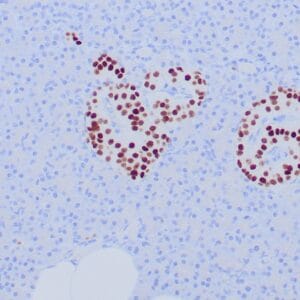
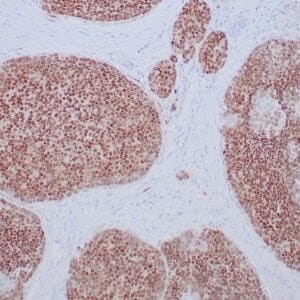
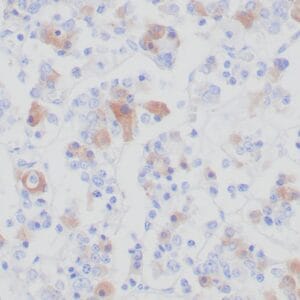
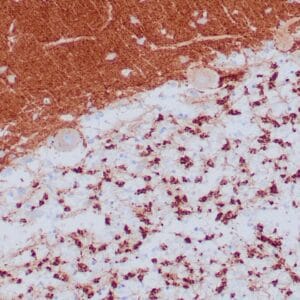
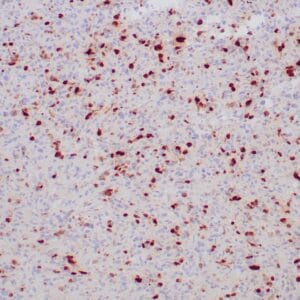

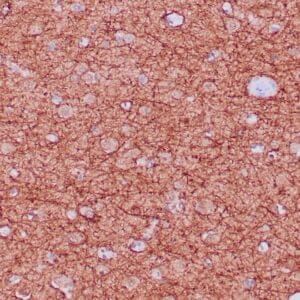
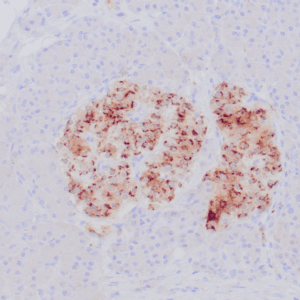
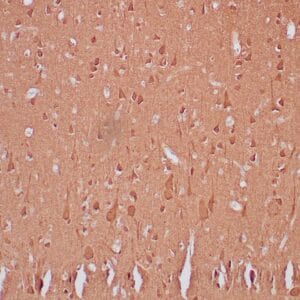
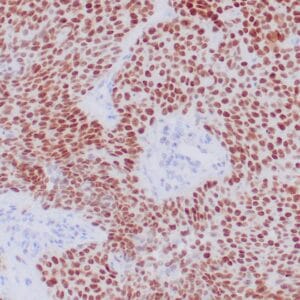
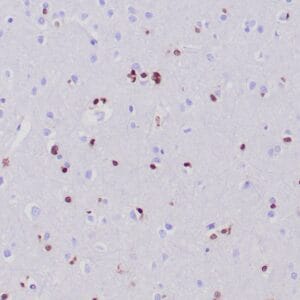
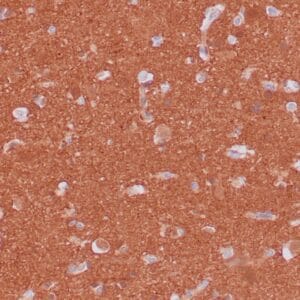
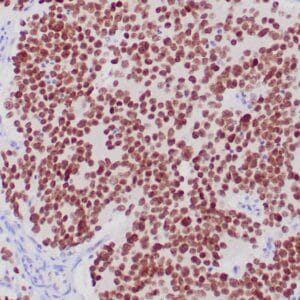
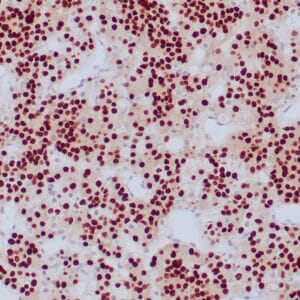
Reviews
There are no reviews yet.